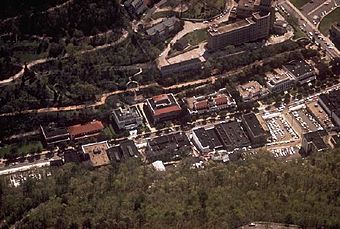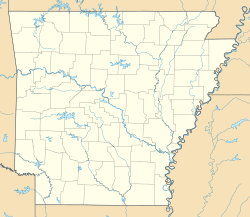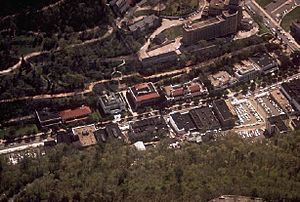Bathhouse Row facts for kids
|
Bathhouse Row
|
|

Aerial view of Bathhouse Row
|
|
| Location | Central Ave. between Reserve and Fountain Sts., in Hot Springs National Park, Hot Springs, Arkansas |
|---|---|
| Area | 6 acres (2.4 ha) |
| Built | 1892+ |
| Architect | several |
| Architectural style | several |
| NRHP reference No. | 74000275 |
Quick facts for kids Significant dates |
|
| Added to NRHP | November 13, 1974 |
| Designated NHLD | May 28, 1987 |
Bathhouse Row is a famous group of historic bathhouses in Hot Springs, Arkansas. These buildings are part of Hot Springs National Park. People came here for centuries to bathe in the natural hot spring waters.
In 1832, the United States government decided to protect this special area. They set aside land to save the 47 natural hot springs. These springs have unique mineral waters that don't smell like sulfur (rotten eggs), unlike many other hot springs. This made the area the first federal reserve in the country.
The bathhouses you see today are the third or fourth set built along Hot Springs Creek. Some were even built right over the hot springs! These buildings were designed around the turn of the 20th century. They show off different fancy styles like Neoclassical, Renaissance Revival, Spanish, and Italianate. They are lined up neatly with grand entrances and outdoor fountains. There are also promenades, which are nice walking paths.
These buildings show how popular "spa" visits were in the 1800s and 1900s. People believed bathing in the hot springs could help with illnesses. However, in the mid-1900s, new medicines were discovered. This made people believe less that hot springs could cure sickness. So, the bathhouse business slowly lost its popularity.
Because of its special history and architecture, Bathhouse Row was named a National Historic Landmark on May 28, 1987.
Contents
What is Bathhouse Row?
Bathhouse Row is a collection of eight historic buildings. They are located in Hot Springs National Park in Arkansas. These buildings were once grand places where people came to relax and bathe. They used the natural hot spring waters. The area is known for its unique history and beautiful architecture.
A Special Place for Hot Springs
The hot springs here have been used for a very long time. Native Americans used them for healing. Later, people from all over the world came to "take the waters." The government protected this area early on. This was to make sure everyone could enjoy the springs. It became a federal reserve in 1832. This was even before the idea of national parks existed!
The Unique Waters
The water from these springs is naturally hot. It comes from deep underground. What makes it extra special is that it doesn't have a strong sulfur smell. Many hot springs smell like rotten eggs because of sulfur. The Hot Springs waters are different. They contain many minerals that people believed were good for their health.
Beautiful Buildings and Their Styles
The bathhouses on Bathhouse Row are very impressive. They were built mostly between 1892 and the early 1900s. Each building has its own unique design. Together, they create a beautiful streetscape.
Different Architectural Styles
The architects who designed these bathhouses used many different styles. You can see elements of:
- Neoclassical architecture: This style looks like ancient Greek and Roman buildings. It often has tall columns and grand entrances.
- Renaissance Revival: This style brings back ideas from the European Renaissance. It often includes fancy decorations and detailed stonework.
- Spanish and Italianate styles: These styles often feature arched windows, decorative tiles, and charming balconies.
The buildings are lined up in a neat row. They have formal entrances and outdoor fountains. There are also wide walking paths called promenades. These features made the area feel grand and welcoming to visitors.
The Rise and Fall of the Spa Era
For many years, visiting spas was very popular in the United States. People believed that bathing in mineral waters could help them feel better. They thought it could even cure some sicknesses. Bathhouse Row was a very famous place for this "spa movement."
Why People Stopped Coming
In the middle of the 20th century (the 1900s), things started to change. Doctors learned more about how to treat illnesses. New medicines were invented. People began to trust modern medicine more than natural hot springs for cures. Because of this, fewer people visited the bathhouses. The spa business slowly declined. Many bathhouses eventually closed down.
Bathhouse Row Today
Even though many bathhouses closed, Bathhouse Row is still an important place. It helps us remember a unique part of American history. Today, some of the old bathhouses have new uses. For example, the Fordyce Bathhouse is now the park's visitor center. You can explore it and learn about the history of the springs. Other bathhouses have been restored and are open for bathing again.
Images for kids






















